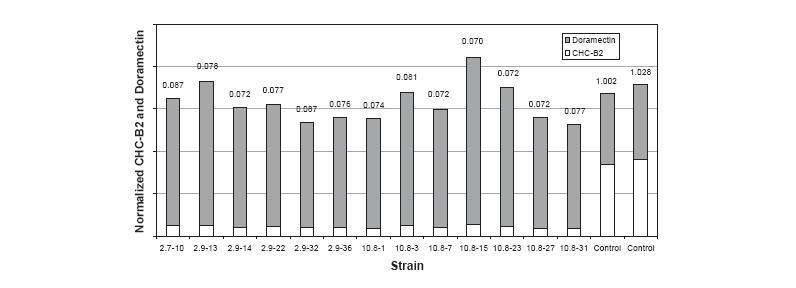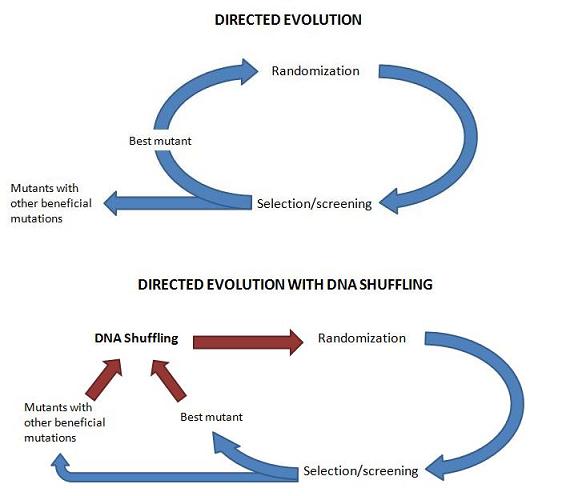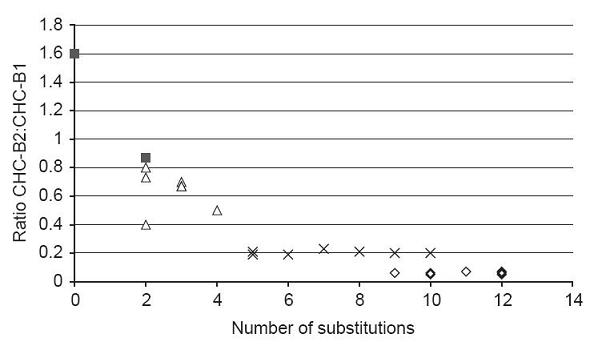Semi-Synthetic DNA Shuffling and Doramectin
Contents
Master
Background
Doramectin is a drug used to treat gastrointestinal roundworms, lungworms, eyeworms, grubs, and sucking lice in cattle. The drug is one of several avermectins, compounds used for the treatment of parasites in animals and river blindness in humans. Over 1 billion dollars is spent each on avermectin derivatives in the United States.
Avermectins are produced by the soil-borne bacteria Streptomyces avermitilis. The subspecies Streptomyces is the largest genus of antibiotic-producing bacteria; erythromycin, neomycin, streptomycin, and tetracycline were all originally derived from species of Streptomyces.
The Goal
Researchers Stutzman-Engwall et al. began their experiment with a strain of S. avermitilis capable of producing doramectin from supplemented cyclohexancaroxylic acid. This strain produced doramectin in two forms: CHC-B1, the most useful form of doramectin, and CHC-B2, a related compound less effective as an antiparasital than CHC-B1. The ratio of ineffective CHC-B2 to effective CHC-B1 produced by this strain was 1:1.
The researchers sought to engineer a strain of S. avermitilis that would produce higher yields of the B1 form of doramectin. The team had already identified that the gene aveC was responsible for the B2:B1 ratio. This knowledge led the team to conduct directed evolution upon the aveC gene.
The Experiment
The researchers conducted three rounds of directed evolution on the aveC gene. To generate a mutant library of the gene, the researchers used the mutagenic agent, Mutazyme, and semi-synthetic DNA shuffling (see following section). The mutant aveC genes were inserted into gene replacement vectors, which were then transformed into S. avermitilis cells. These cells were diluted into 96 well plates for high throughput culturing under conditions suitable for doramectin production. Selection of the best mutants was conducted by testing the doramectin output and B2:B1 ratios of each well (quantifiable with MS/MS). DNA isolated was isolated from the best mutants and the aveC gene was amplified using PCR. The amplified DNA from these mutants was recombined using semi-synthetic shuffling, subjected to random mutagenesis, and resubmitted to selection.
After three rounds of directed evolution, the resulting strains of S. avermitilis produced doramectin with a B2 to B1 ratio of 0.07:1 (Fig. 1); This ratio was significantly lower than the ratio in wild-type strain of S. avermitilis (1:1).
(Stutzman-Engwall et al., 2005 - Permission Pending)
Figure 1 - Doramectin production profiles of thirteen strains of S. avermitilis transformed with the most evolved form of the aveC gene after three rounds of directed evolution. Numbers above each bar represent ratios of CHC-B2 to doramectin produced by the strain. Fermentation analysis for each strain was conducted in a 30 mL shake flask under humidity for 12-14 days. Each strain in which wild-type aveC had been replaced by the evolved aveC displayed a significant reduction in the B2:B1 (B2:Doramectin) ratio.
Semi-synthetic DNA Shuffling
During the process of genetic randomization in this experiments, the researchers used a technique termed DNA shuffling. This technique, sometimes called sexual PCR, involves artificially recombining the genes of the best mutants at the end of each round of selection. Through these recombinations, beneficial mutations which are lost during the selection process are recaptured (Fig. 2).
Figure 2 - Unlike directed evolution alone, directed evolution with DNA shuffling reinserts the best mutations of a generation rather than simply an individual.
The first step of DNA shuffling involves digesting the gene of interest with DNAse1 into fragments. Primerless PCR is then conducted on these fragments; under these conditions, Taq polymerase is able to reassemble the fragmented gene. Hopefully, during this fragmenting and reassembling of the gene of interest, different mutations proven beneficial by selection during directed evolution are recombined into a single gene (Fig. 3).
(Stemmer 1994 - Permission Pending)
Figure 3 - DNA shuffling uncoupling beneficial mutations (represented by X's) and recombining them through gene reassebmly. Product represents the theoretical best output of DNA shuffling.
The work by Stutzman-Engwall et al. represents a further development on the technique of DNA shuffling. They have termed their new method "semi-synthetic DNA shuffling." This method followed the same protocol as DNA shuffling described above, except that all beneficial mutations of the aveC gene were stored as oligonucleotides. By this method, beneficial mutations can be continuously reintroduced by inserting these oligonucleotides in high molar concentrations during DNA shuffling. The researchers hypothesized this new development in DNA shuffling would prevent beneficial mutations from being lost. Furthermore, this technique allowed the team to introduce four mutations previously demonstrated to lower the B2:B1 doramectin ratio into the shuffling scheme.
Although we are unable to tell how their new technique compared to directed evolution with normal DNA shuffling or directed evolution without any DNA shuffling altogether, there is a clear correlation between enrichment in mutations and improvement of phenotype as successive rounds of semi-synthetic DNA shuffling were completed (Fig. 4).
(Stutzman-Engwall et al., 2005)
Figure 4 - The ratio of CHC-B2:CHCB1 vs. the number of amino acid substitutions in the clone compared to the wild type. The first square represents wild-type S. avermitilis and the second square represents the production strain of S. avermitilis subjected to directed evolution. Triangles represent the best clones from the first round; Xs represent te best clones from the second round; diamonds represent best clones of the third round. Each round of directed evolution using semi-synthetic shuffling shows both an increase in doramectin production phenotype and number of mutations in the evolved clone.
Conclusion
Semi-synthetic shuffling proved successful in quickly and efficiently improving the function of the aveC gene.



